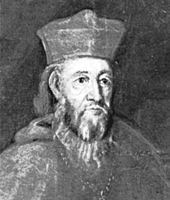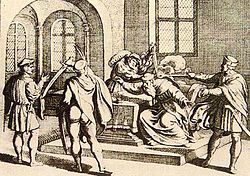- George Martinuzzi
-
George Martinuzzi (born Juraj Utješinović, also Georg Utiessenovicz-Martinuzzi or George Utissenich; *1482 – †December 16, 1551) was a Croatian nobleman, a monk, bishop of Oradea, archbishop of Esztergom, cardinal and Hungarian statesman.
Contents
Biography
Martinuzzi was born in Kamičac, Dalmatia (southern Croatia). He is, as he usually signed himself Frater Georgius, known in Hungarian history as Fráter György or simply Tux Frate. He was the son of Grgur Utješinović (English: Gregory Utissenich), a Croatian nobleman, and was named Juraj Utješinović, but he used his mother's family name Martinuzzi, a Venetian patrician family. His sister Ana married Bartol Drašković and had three sons, among which was the famous Croatian Ban (viceroy) and cardinal Juraj Drašković.
From his eighth to his twentieth year he was attached to the court of János Corvinus; subsequently, entering the service of the Zápolya family, he saw something of warfare under John Zápolya but, tiring of a military life, he entered The Order of Saint Paul the First Hermit and became a monk at the age of twenty-eighth.
His historical career began when his old patron Zápolya, now king of Hungary, forced to fly before his successful rival Ferdinand, afterwards the emperor Ferdinand I, sent him on a diplomatic mission to Hungary. It was due to his tact and ability that John recovered Buda (1529), and henceforth Fráter György became his treasurer and chief counsellor. In 1534 he became bishop of Oradea; in 1538 he concluded with Austria the Treaty of Oradea, whereby the royal title and the greater part of Hungary were conceded to Zápolya. John Zápolya left the Frater the guardian of his infant son John Sigismund, who was proclaimed and crowned king of Hungary, the Fráter acting as regent. He frustrated all the attempts of the queen mother, Isabella Jagiellon, to bring in the Austrians, and when, in 1541, an Austrian army appeared beneath the walls of Buda, he arrested the queen and applied to the Porte for help.
On August 28, 1541, the Fráter did homage to the sultan, but during his absence with the baby king in the Turkish camp, the grand vizier took Buda by subtlety. Then only the Fráter recognized the necessity of a composition with both Austria and Turkey. He attained it by the treaty of Gyula (December 29, 1541), whereby western Hungary fell to Ferdinand, while Transylvania, as an independent principality under Turkish suzerainty, reverted to John Sigismund. It included, besides Transylvania proper, many Hungarian counties on both sides of the Theiss, and the important city of Košice. It was the Fráter's policy to preserve Transylvania neutral and intact by cultivating amicable relations with Austria without offending the Porte. It was a difficult policy, but succeeded brilliantly for a time.
In 1545, encouraged by the growing unpopularity of Ferdinand, owing to his incapacity to defend Hungary against the Turks, the Fráter was tempted to unite Austrian Hungary to Transylvania and procure the election of John Sigismund as the national king. But recognizing that this was impossible, he aimed at an alliance with Ferdinand on terms of relative equality, and to this system he adhered until his death.
Queen Isabella, who hated the Fráter and constantly opposed him, complained of him to the sultan, who commanded that either the traitor himself or his head should be sent to Constantinople (1550). A coalition was then formed against him of the queen, the hospodars of Moldavia and Wallachia and the Turks; but the Fráter shut the queen up in Alba Iulia, drove the hospodars out of Transylvania, defeated the Turks at Deva, and finally compelled Isabella to accept a composition with Austria very profitable to her family and to Transylvania, at the same time soothing the rage of the sultan by flatteries and gifts. This compact, a masterpiece of statesmanship, was confirmed by the diet of Cluj Napoca in August 1551. The Fráter retained the governorship of Transylvania, and was subsequently consecrated archbishop of Esztergom and received the red hat. Thus Hungary was once more reunited, but the inability of Ferdinand to defend it against the Turks, as promised, forced the Frater, for the common safety, to resume the payment of tribute to the Porte in December 1551. However, the Turks no longer trusted a diplomat whose behavior they could not understand, while Ferdinand suspected him of an intention to secure Hungary for himself.
When the Turks (in 1551) took Cenad and other places, the Fráter and the imperial generals Giambattista Castaldo and Pallavicini combined their forces against the common foe; but when the Fráter privately endeavoured to mediate between the Turks and the Hungarians, Castaldo represented him to Ferdinand as a traitor, and asked permission to kill him if necessary. The Fráter's secretary Marco Aurelio Ferrari was hired, and stabbed his master from behind at the castle of Vinţu de Jos while reading a letter, on December 16, 1551; but the cardinal, though in his sixty-ninth year, fought for his life, and was only dispatched with the aid of Pallavicini and a band of bravos. Ferdinand took the responsibility of the murder on himself. He sent to Pope Julius III an accusation of treason against the Fráter in eighty-seven articles, and after long hesitation, and hearing one hundred and sixteen witnesses, the pope exonerated Ferdinand of blame.
References
 This article incorporates text from a publication now in the public domain: Chisholm, Hugh, ed (1911). Encyclopædia Britannica (11th ed.). Cambridge University Press.
This article incorporates text from a publication now in the public domain: Chisholm, Hugh, ed (1911). Encyclopædia Britannica (11th ed.). Cambridge University Press.
Further reading
- A. Bechet, Histoire du ministére du cardinal Marlinusius (Paris, 1715); O. M. Utieienovi, Lebensgeschichte des Cardinals Georg t.Jliesenoviil (Vienna, 1881); Codex epistolaris Fratris Georgii 1535-1551, ed. A. Krolyi (Budapest, 1881). But the most vivid presentation of Fráter is to be found in M. Jókais' fine historical romance, Brother George (Hung.) (Budapest, 1893).
External links
Categories:- 1482 births
- 1551 deaths
- 16th-century Hungarian people
- 16th-century Roman Catholic archbishops
- Hungarian cardinals
- Rulers of Transylvania
- Archbishops of Esztergom
- People from Dalmatia
- Hungarian people of Croatian descent
Wikimedia Foundation. 2010.


